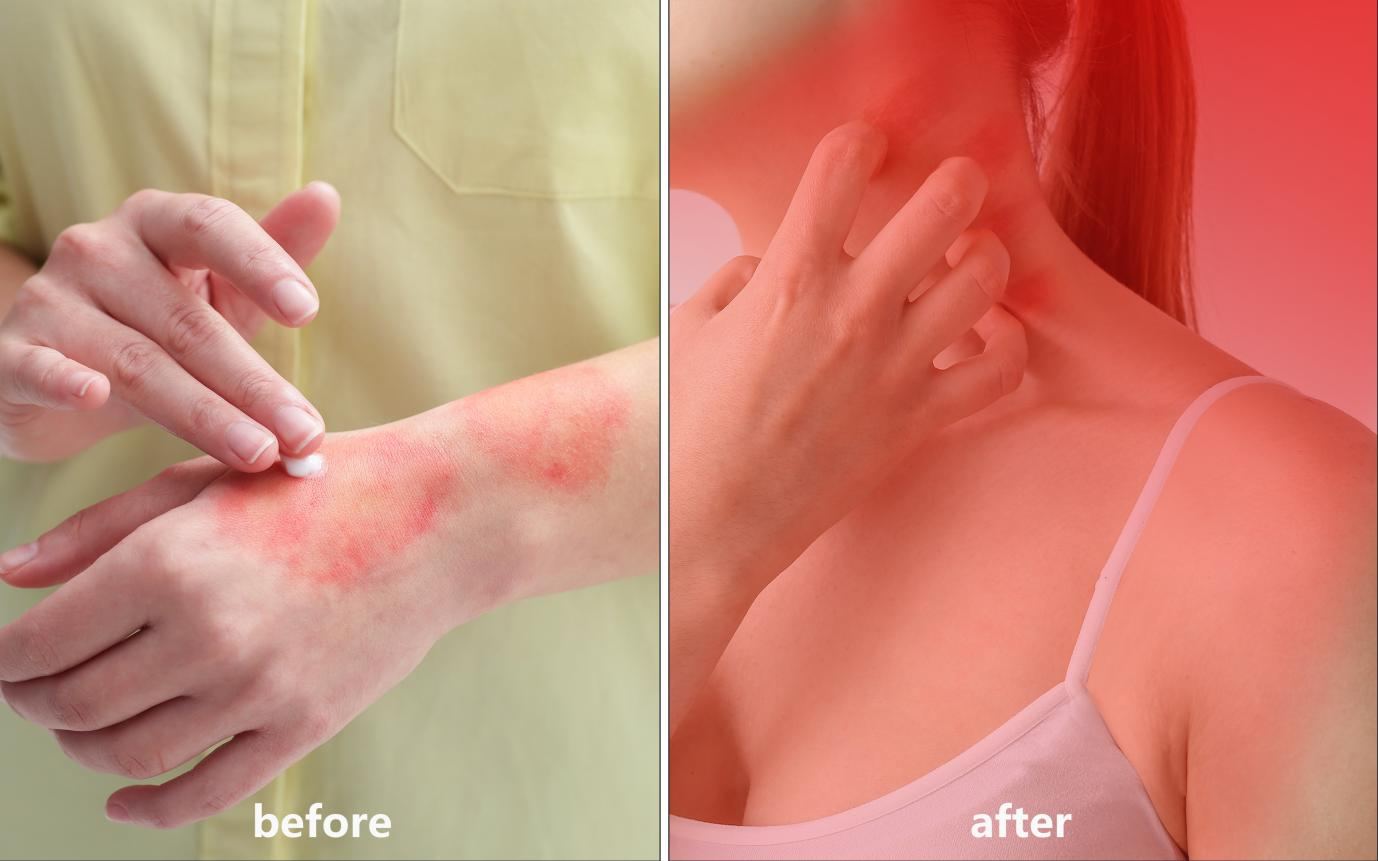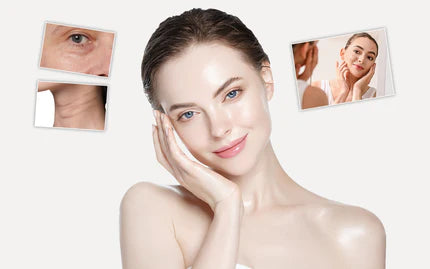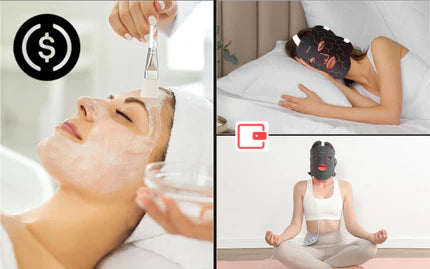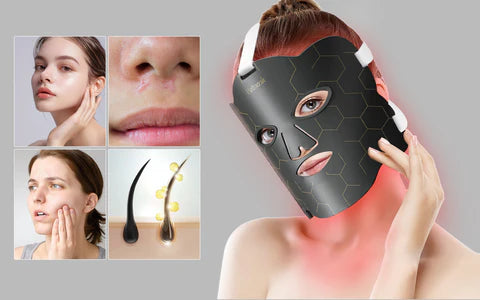Eczema, also known as atopic dermatitis, is more than just a skin condition—it’s a chronic struggle that affects millions with its hallmark symptoms of relentless itchiness, inflammation, and dry patches. In the quest for relief, patients and dermatologists alike are now turning their attention to an innovative solution: red light therapy masks. Promising gentle treatment without the harsh effects of traditional methods, these masks have begun to shine a new light on ecuberant hope for those seeking to soothe their troubled skin. This article delves into the transformative impact red light therapy masks are having on eczema treatment, offering a ray of hope for clearer, calmer skin.

1. What Are the Symptoms of Eczema?
When it comes to eczema, the symptoms are not just skin-deep; they also reach into daily life and well-being. Let’s outline the most common ones:
Primary Symptoms of Eczema:
- Itching: This isn’t just a small annoyance — it’s an intense, often overwhelming need to scratch.
- Redness: The skin can look angry and inflamed, which is as uncomfortable as it sounds.
- Dry Skin: We’re talking about skin that feels rough, looks flaky, and sometimes cracks open.
These are the main signs that someone might be dealing with eczema. They’re what doctors look for, and they’re what can really affect someone’s day-to-day comfort.
But there’s more to it. Eczema can also lead to issues that aren’t as visible:
Secondary Effects of Eczema:
- Sleep Problems: Imagine trying to sleep when your skin is crawling with itchiness. It’s tough and can lead to not getting enough shut-eye.
- Social Stress: When eczema flares up, it can make people feel self-conscious or shy around others because of how their skin looks or feels.
These points show that eczema can do a number on someone’s overall quality of life. They highlight why it’s so important to treat both the skin symptoms and the other ways eczema can make life harder. Understanding everything eczema brings to the table helps in finding the best way to tackle it head-on.
2. What Are the Causes of Eczema?
Eczema’s origins can be complex, weaving together genetic factors and various external elements. Let’s break down these contributors to get a clearer picture:
The Genetic Puzzle Pieces
- Inherited skin barrier defects: Some genes involved in forming the skin’s protective layer don’t function properly, leading to vulnerability.
- Family history of eczema, allergies, or asthma: A common trio suggesting a hereditary predisposition.
Genetics set the stage for eczema, but they’re just one part of the equation. These inherited aspects underline why some individuals are more prone to developing the condition than others, establishing an inherent sensitivity from birth.
Triggers in Our Environment
- Skincare products with harsh chemicals: Potential irritants that disrupt the skin barrier.
- Fabrics like wool or synthetics: Materials that can irritate sensitive skin.
- Weather changes: Fluctuations in humidity and temperature can instigate flare-ups.
- Allergens: Pollen, pet dander, and dust mites are common environmental triggers.
Though we cannot control our genetic makeup, managing environmental factors can help mitigate eczema’s severity. Recognizing and avoiding known irritants is a pivotal step in this ongoing balancing act.
Lifestyle’s Link with Eczema
- Dietary choices: Certain foods may aggravate symptoms, while anti-inflammatory options could offer relief.
- Hydration habits: Adequate water intake is essential for maintaining skin moisture.
- Stress levels: High stress can lead to increased inflammation and worsened eczema.
- Sleep quality: Poor sleep can exacerbate the body’s inflammatory responses.
Our lifestyle choices often reflect on our skin. By cultivating habits that bolster overall health, those with eczema can aim to keep their symptoms in check as much as possible.
Managing eczema requires a holistic approach. It’s not only about treating the skin but also understanding and addressing the underlying triggers that bring about this challenging condition. With this comprehensive approach, treatments such as red light therapy can be utilized more effectively, targeting the symptoms with precision while considering the root causes.
3. The Science Behind Red Light Therapy and Skin Health
Red light therapy is emerging as an effective treatment for eczema due to its ability to address the condition at a cellular level. This type of therapy provides several benefits that help improve skin health, particularly for those suffering from chronic skin conditions like eczema.
The science-backed advantages of red light therapy include:
- Cellular Energy Boost: The therapy delivers red light to the skin, which increases energy production in skin cells, helping them to function better and heal damaged skin.
- Enhanced Circulation: It improves blood flow to the skin, which is crucial for bringing in nutrients and oxygen that support skin repair and health.
- Inflammation Reduction: Red light therapy has been shown to reduce inflammation in the skin, which is especially beneficial for reducing the redness and swelling associated with eczema.
- Research-Backed Results: Studies have demonstrated that red light therapy can alleviate symptoms of eczema, leading to improvements in skin texture and a decrease in the occurrence of flare-ups.
Red light therapy presents a promising option for people with eczema. With its ability to enhance cell function, boost circulation, and calm inflammation—all verified by scientific research—it offers a way to not only ease the symptoms but also potentially to improve the overall health of the skin. As more individuals turn to this treatment, it could become a cornerstone in the management of eczema. Click to learn more about the steps and techniques of red light therapy skin care.

4. Benefits of Red Light Therapy Masks in Managing Eczema
Red light therapy masks have emerged as a supportive home treatment for individuals with eczema, offering various benefits that leverage the therapeutic effects of red light. Here’s an overview of how these devices can be advantageous for those dealing with this skin condition:
- Targeted Treatment: These masks are designed to fit snugly over the face, ensuring that the beneficial light is directed precisely where it’s needed, which can be particularly useful for facial eczema.
- Convenience: The ability to use the mask at home saves time and could be less stressful for those who find regular clinic visits inconvenient or anxiety-inducing.
- Ease of Use: With straightforward instructions, these masks are typically user-friendly. Most come with a simple on/off switch and a timer, making it easy to incorporate the treatment into your daily routine.
- Cost-Effectiveness: While there’s an upfront cost, investing in a mask can be more economical in the long run compared to the ongoing expenses of professional treatments.
- Consistency of Treatment: Having a device readily available at home may encourage more regular and consistent treatment sessions, which is key for seeing results with red light therapy.
- Safety and Comfort: Home-use masks are designed with consumer safety in mind, often including features such as auto shut-off and eye protection. Being able to use the mask in the comfort of your own home adds to the overall positive experience.
- Potential for Improved Skin Health: Regular use of red light therapy masks can help Treating facial acne and increasing collagen production helps carry aging, which might lead to healthier skin and potential easing of eczema symptoms like redness, itching, and dryness.
Red light therapy masks serve as a beneficial addition to the arsenal of tools for managing eczema. They offer the dual convenience of at-home treatment and the potential for improved skin health, all while providing a safe and comfortable way to possibly reduce the severity of eczema symptoms. As always, it’s important for users to consult with healthcare professionals before beginning new treatments to ensure they align with their specific health needs and conditions.
5. Advantages of Red Light Therapy Masks Compared to Traditional Eczema Treatments
Red light therapy masks are gaining popularity as a treatment for eczema, offering some advantages over traditional treatments such as topical steroids.
- No Harsh Chemicals: Unlike many creams and ointments, red light therapy doesn’t involve any chemicals, which means there’s no risk of the skin developing reactions to harsh ingredients.
- Reduced Risk of Side Effects: Topical steroids can sometimes cause side effects like thinning of the skin or changes in pigmentation when used extensively. Red light therapy generally has fewer potential side effects.
- Non-Invasive: This therapy is non-invasive and does not require any recovery time, whereas some traditional treatments may cause discomfort or require a period of healing post-application.
- Ease of Use: With red light therapy masks, there’s no mess involved. You don’t have to deal with the application and reapplication of creams or ointments, which can be time-consuming and sometimes inconvenient.
- Cumulative Benefits: The effects of red light therapy can be cumulative, meaning that with regular use, the benefits for skin health—like reduced inflammation and enhanced healing—can build over time.
- Complementary Treatment: These masks can be used in combination with other treatments without interfering with them, providing a holistic approach to managing eczema.
With the ease of use and potential for cumulative skin health benefits, red light therapy masks are well-suited for those seeking a non-invasive complement to their existing eczema management plan.

Key Takeaways
Offering a gentle and non-invasive treatment option, red light therapy masks bring new hope to many. They’re practical, easy to use, and avoid the harsh side effects often seen with traditional treatments. More than just treating symptoms, red light therapy masks fit effortlessly into daily routines, making them a convenient solution for ongoing skin care. For anyone struggling with the constant itch and irritation of eczema, these masks aren’t just another treatment method—they’re a step towards a more comfortable life and healthier skin.






